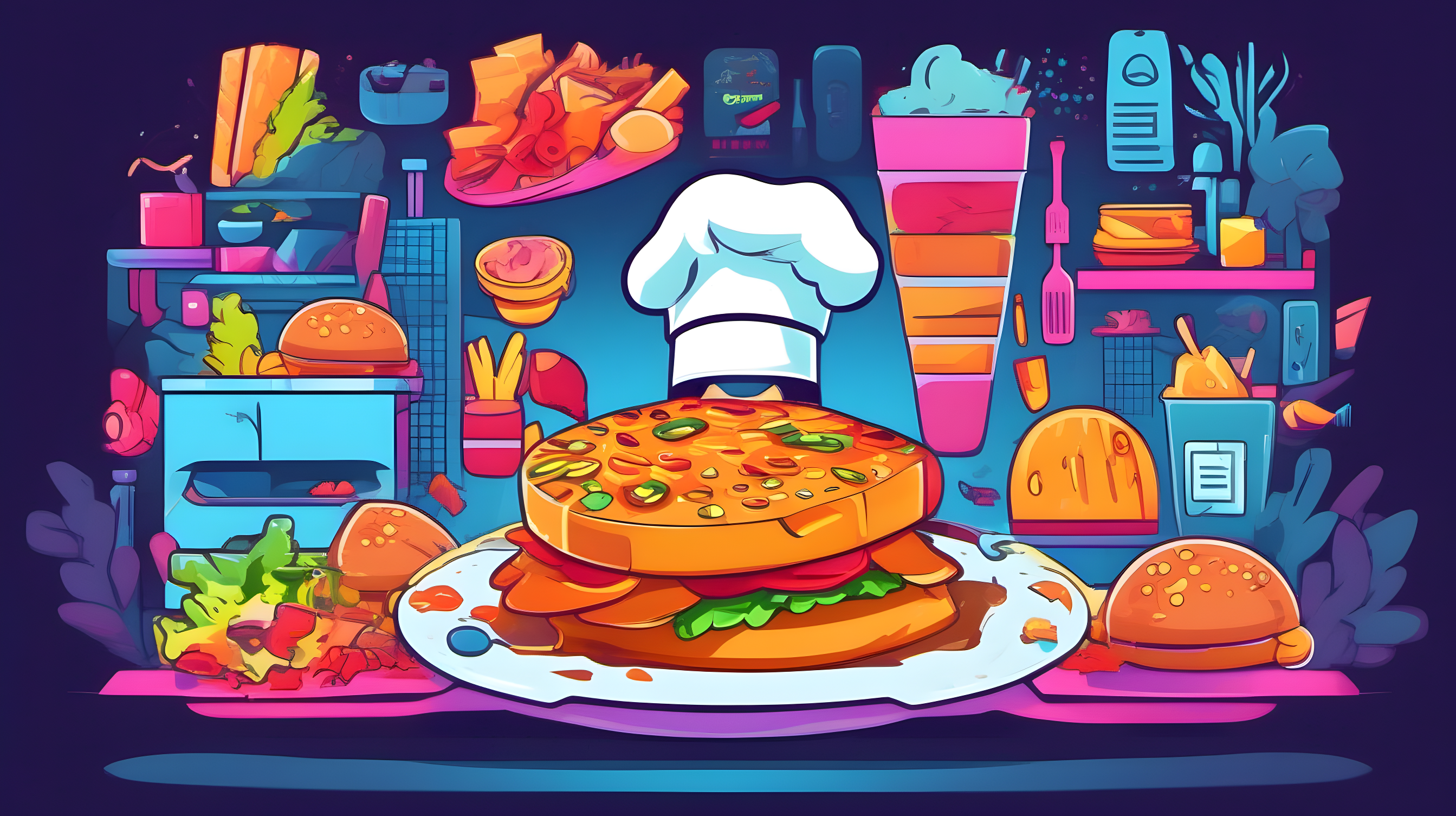How an AI Copilot Can Supercharge Quick Service Restaurants?

You are fretting over the fryer, trying to keep up with orders during the lunch rush. Omnichannel customer orders are piling up from the counter, kiosk, drive thru, order ahead, and third-party food apps like Uber Eats. Your short-handed staff are frantically attempting to keep up.
When your Quick Service Restaurant (QSR) outlets have operational interruptions like systems, power outages, and network outages, both the franchisor and franchisees are negatively impacted.
Another constraint is that QSR outlets are limited by their size, staff, and operating hours which results in an upper limit on the amount of food and beverages that they can serve. This imposes an upper limit on the same-store sales and profits.
You wish you had some way to grow the business and make it run smoother!
Typically, a fast-food restaurant isn’t thought to be a “high-tech” operation that invests heavily in innovative IT infrastructure and applications. The pandemic changed both the nature of the way restaurants are patronized and how they operate.
What if the QSRs could use digital technology cost-effectively to dramatically improve customer experience, efficiency, revenue, and profitability by using Generative Ai?
QSRs: More Than Just Burgers and Fries
- When you think of a quick-service restaurant, fast food chains like McDonald’s, Burger King, and Taco Bell probably come to mind. However, QSRs encompass more than just burgers and fries. They include sandwich shops, pizza places, coffee spots like Starbucks, and more.
These restaurants share some key qualities:
- Customers order at a counter or drive-thru or via an app, rather than having table service.
- Food comes out fast, ideal for a quick meal on the go.
- Limited menus focusing on signature items customers crave.
- Affordable prices that appeal to budget-conscious diners.
As a QSR store manager, you juggle many responsibilities – serving customers, growing the business, watching your costs, hiring staff, monitoring inventory, and keeping the service quick. With slim profit margins, finding ways to boost revenue and efficiency is key. Could Ai be the solution you have been seeking?
Artificial Intelligence to the Rescue
Ai is already all around us in our everyday lives in navigation apps like Google maps, streaming services like Netflix and Amazon Prime utilize Ai to make recommendations based on your viewing history email providers filter out spam using Ai, and Alexa and Siri rely on basic Ai to understand commands.
In a nutshell, Ai refers to computer systems and software in the cloud that are continuously learning and perform tasks like making predictions or recommendations by analyzing data patterns. For a restaurant, instead of robot chefs flipping burgers, Ai offers specific ways to help your business.
Specific Ways Generative Ai Can Help Your QSR
Data Engineering: What Ai Runs On
That all sounds great, but how exactly will Ai make my crazy QSR life easier, you ask? Well, let us dish out some tangible benefits of an Ai 2.0 strategy for your business:
Customer Experience: Make Customers Happier Than a Kid in a Candy Store
You know how good it feels when you walk into a business, and they know your name or favorite order? It makes you feel special. Ai provides that same personalized experience for your customers. By collecting data on previous transactions, Ai develops customer profiles. So, when regulars come in, you can give them targeted promotions for their favorite food items or something new to try based on their preferences. This makes people feel valued.
Ai chatbots on your web portal enable better eCommerce customer experience by offering personalized promotions and menu suggestions to individual customers
based on their past orders, provide 24/7 automated customer service, take orders, and handle basic inquiries.
Ai never loses its cool with grumpy customers!
Sales: Boost Revenue Like a Storewide Sale
Ai helps grow your wallet in several ways. With demand forecasting, you can ensure you have enough ingredients and staff on hand for a projected busy rush. This lets you serve more customers faster when you have the most potential sales. It’s like flipping the open sign during a huge sale!
And since Ai is an expert at detecting patterns in data, it identifies menu items that are generating the most profit relative to their production cost and popularity. This insight allows you to double down on the winners.
Ai even suggests completely new menu items you should offer based on food trends and local customer taste preferences. More menu options your patrons get excited about equal more sales!
Save Time and Money with Predictive Operations
Owning a restaurant often feels like getting stuck on a treadmill where you keep running just to avoid falling off. Ai helps take some of that pressure off by boosting efficiency. For example, by reviewing past sales data and seasonality, Ai forecasts demand surges for big game days, holidays, concerts, or other local events.
With these demand predictions, you can adjust staff schedules and order the optimum amount of ingredients and supplies ahead of time. This prevents wasting money on labor for idle staff or food that just gets tossed in the trash. Plus shortening wait times increases customer satisfaction. It’s a win-win!
Ai enables aggregation of online, line-busting, drive-thru, and in-store orders to a single preparation workflow for execution and monitoring.
Ai analyzes your operational data to detect inefficient processes and recommends ways to optimize things like inventory management, supply chains or production workflows. Every money-saving improvement goes straight to your bottom line.
Efficiency: Reduce Equipment Failures
Like an infomercial showing someone hilariously battling everyday tasks, equipment breakdowns can make running a restaurant feel like a game of whack-a-mole. Ai puts an end to fighting with broken dishwashers, temperamental grills, and computers constantly needing rebooting.
By monitoring Internet of Things (IoT) sensor data across your equipment, Ai picks up on changes and predicts when maintenance will be needed before something shuts down. Predictive maintenance means preventing unpleasant surprises and scrambling when your most important kitchen gear suddenly fails right before the dinner rush.
Operational View: Get a Superpowered Crystal Ball
Juggling the moving parts of a restaurant often feels like steering a ship through dense fog. You lose track of what's working, what's not and where icebergs might be lurking. Wouldn't it be nice to have a crystal ball showing you real-time stats?
Ai’s constant data crunching essentially gives you this power. Whether it’s sales, customer satisfaction, inventory levels, equipment performance or other metrics, Ai gives you an up-to-the minute pulse check on your entire operation.
Problems can be spotted instantly, not days or weeks later. And slower periods that might have gone unnoticed previously become obvious, allowing you to run targeted promotions to fill seats. It’s like gaining superhuman senses!
Data Engineering: What Ai Runs On
Like a car needs gas, data is the lifeblood of Ai. The more quality data the better. For a QSR, data comes from:
- Point of sale and online order systems.
- Inventory and supply chain management.
- Customer relationship management.
- Equipment sensors and IoT devices.
- Utilities and facilities management.
- External sources like network operations, weather, and local events.
Using data engineering Ai crunches this data to serve up insights.
Complementary Technology Innovation
While crafting an Ai strategy for QSRs, it is important to consider complementary industry 4.0 technologies that work together with Ai in meaningful ways. These include intelligent cloud services, edge devices, UI/UX such as mobile apps for customers, dashboards and reporting for employees and management, AR/MR for improved employee productivity, blockchain, cybersecurity, and NLP for customers and employees to better engage with your brand externally and internally.
Getting Started with Ai Strategy and Implementation
Ready to enjoy the benefits of Ai for your QSR?
Your Ai strategy fits perfectly into your uber digital transformation strategy for your business. Engage with an Ai services company that understands business and your industry, has extensive background in data engineering for Ai, and has experience implementing solutions on the cloud & Ai platforms from Microsoft, AWS, etc. They will need to work closely as an extension of your in-house team to implement the technology solution needed to achieve the desired business outcomes. Here are some pro-tips:
Discovery: Assess your needs to understand the QSR pain points that Ai could alleviate. This includes an ideation workshop to understand the state of the possible with Ai.
Data Engineering: What data sources do you already have? Identify any gaps.
Partner Selection: Choose an experienced partner who can tailor an Ai solution for your business.
Start Small: Identify and prioritize one or few meaningful use cases before expanding.
Integrate: Blend Ai seamlessly with your existing POS, inventory, and other systems.
Change Management: Communicate your Ai strategy clearly and help your people through the adoption curve.
Operation: Deploy the solution. Monitor tangible benefits. Tune and expand.
QSRs that use Ai are well positioned to increase revenue and profits without adding space, staff, or more operating hours.
Tom Dickhaus. Vish Thirumurthy. Tev5 Digital. Rev G.
#QSR #quickservicerestaurant #fastfood #Ai #artificialintelligence #generativeAi #genAI #Ai2.0 #digital #digitaltransformation #Tev5Digital
Recent Post
- Ai, digital, Industry
- January 21, 2024
